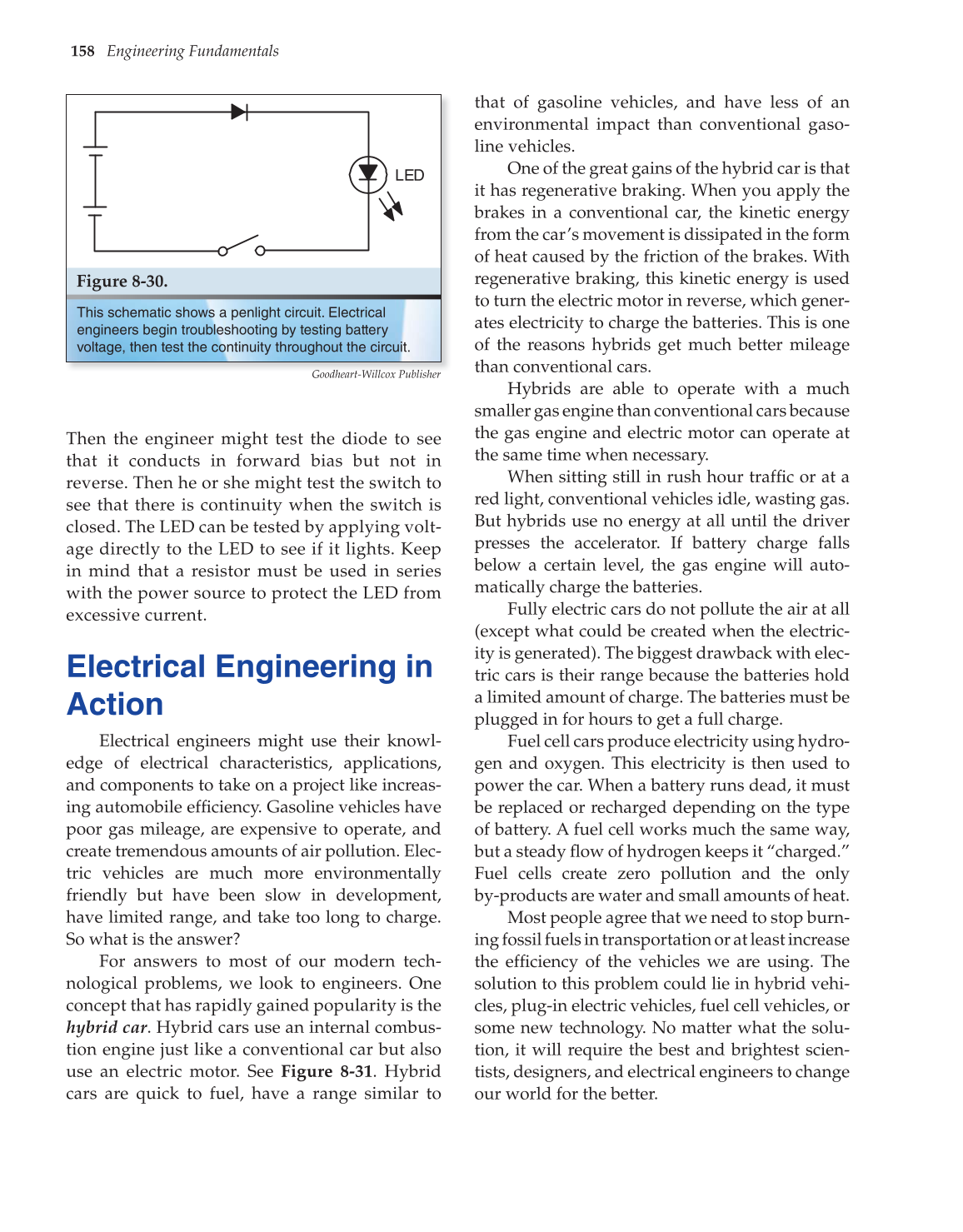158 Engineering Fundamentals
Then the engineer might test the diode to see
that it conducts in forward bias but not in
reverse. Then he or she might test the switch to
see that there is continuity when the switch is
closed. The LED can be tested by applying volt-
age directly to the LED to see if it lights. Keep
in mind that a resistor must be used in series
with the power source to protect the LED from
excessive current.
Electrical Engineering in
Action
Electrical engineers might use their knowl-
edge of electrical characteristics, applications,
and components to take on a project like increas-
ing automobile effi ciency. Gasoline vehicles have
poor gas mileage, are expensive to operate, and
create tremendous amounts of air pollution. Elec-
tric vehicles are much more environmentally
friendly but have been slow in development,
have limited range, and take too long to charge.
So what is the answer?
For answers to most of our modern tech-
nological problems, we look to engineers. One
concept that has rapidly gained popularity is the
hybrid car. Hybrid cars use an internal combus-
tion engine just like a conventional car but also
use an electric motor. See Figure 8-31. Hybrid
cars are quick to fuel, have a range similar to
that of gasoline vehicles, and have less of an
environmental impact than conventional gaso-
line vehicles.
One of the great gains of the hybrid car is that
it has regenerative braking. When you apply the
brakes in a conventional car, the kinetic energy
from the car’s movement is dissipated in the form
of heat caused by the friction of the brakes. With
regenerative braking, this kinetic energy is used
to turn the electric motor in reverse, which gener-
ates electricity to charge the batteries. This is one
of the reasons hybrids get much better mileage
than conventional cars.
Hybrids are able to operate with a much
smaller gas engine than conventional cars because
the gas engine and electric motor can operate at
the same time when necessary.
When sitting still in rush hour traffi c or at a
red light, conventional vehicles idle, wasting gas.
But hybrids use no energy at all until the driver
presses the accelerator. If battery charge falls
below a certain level, the gas engine will auto-
matically charge the batteries.
Fully electric cars do not pollute the air at all
(except what could be created when the electric-
ity is generated). The biggest drawback with elec-
tric cars is their range because the batteries hold
a limited amount of charge. The batteries must be
plugged in for hours to get a full charge.
Fuel cell cars produce electricity using hydro-
gen and oxygen. This electricity is then used to
power the car. When a battery runs dead, it must
be replaced or recharged depending on the type
of battery. A fuel cell works much the same way,
but a steady fl ow of hydrogen keeps it “charged.”
Fuel cells create zero pollution and the only
by-products are water and small amounts of heat.
Most people agree that we need to stop burn-
ing fossil fuels in transportation or at least increase
the effi ciency of the vehicles we are using. The
solution to this problem could lie in hybrid vehi-
cles, plug-in electric vehicles, fuel cell vehicles, or
some new technology. No matter what the solu-
tion, it will require the best and brightest scien-
tists, designers, and electrical engineers to change
our world for the better.
LED
This schematic shows a penlight circuit. Electrical
engineers begin troubleshooting by testing battery
voltage, then test the continuity throughout the circuit.
Figure 8-30.
Goodheart-Willcox Publisher
